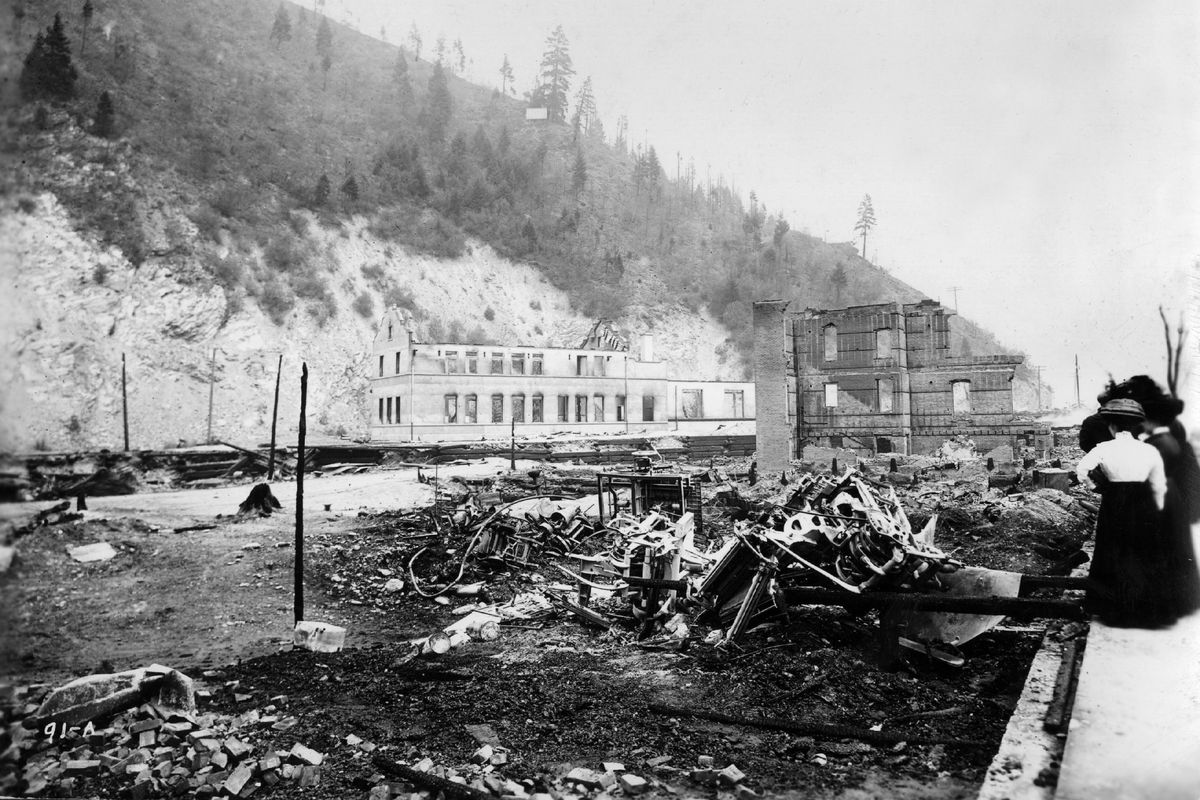Big Burn, great losses
1910 fire killed scores, scorched nearly 3 million acres, Wallace

The Big Burn of 1910, the largest forest fire in United States’ history, inflicted a terrible toll on Eastern Washington, North Idaho and Western Montana.
Precise reporting is difficult because there are many discrepancies about the fire records. For instance, some reports say there were 1,736 fires burning in North Idaho and Western Montana on Aug. 19; others say 3,000. However, it doesn’t matter much. For when the big blowup came that day and the next, owing to hurricane-force winds, it seemed like there was only one huge inferno.
The Big Burn killed 86 to 88 people, although an exact count will never be known because recordkeeping was imprecise, people were scattered throughout the wilderness, and some bodies were entirely consumed by flames in the intense heat.
Nearly 3 million acres burned, consuming over 7 billion board feet of timber. That was enough to build more than 50,000 four-room houses. By one estimate, the property losses amounted to $13.5 million. That would be about $314 million today.
The greatest loss of life was among firefighters. Seventy-eight of them died; the rest were civilians.
Most of the area burned was unroaded wilderness peopled by settlers and those engaged in logging, mining and railroad construction. But a few settlements were wholly or partially consumed, including Avery, Grand Forks, Kyle and Falcon, Idaho, and Taft, DeBorgia, Henderson and Haugan, Mont. There was even a city, Wallace.
Before the fire leapt into that city of about 3,000, residents tried a creative solution: Prank Brooks, a balloonist, ascended into the smoky sky with a load of dynamite he was to set off at 5,000 feet to emulate thunder and lightning and bring on the rains. He never made it. He reached only 1,600 feet because the air was so smoky and the winds so adverse he couldn’t rise higher.
As early as Aug. 14 firebrands lofted by heavy winds blew into town from miles away and set awnings afire. Insurance men got busy. Incredibly, they were selling policies to all who wanted to buy until noon on Aug. 20.
That evening, Mayor Walter Hanson ordered every able-bodied man to report for fire duty, threatening jail for those who did not. Those “volunteers” plus members of the city fire department and soldiers of the 25th Infantry on duty in Wallace tried to set backfires, but there is disagreement as to whether or not their efforts were what saved most of the town.
At about 9 p.m. the fire came out of Placer Creek Canyon to the southwest. The winds were so strong that the fire jumped the main section of town and struck its east side. About a third of Wallace burned and two people were killed. Another account suggests there was a third fatality.
One was Joseph Boyd, a pioneer of the Coeur d’Alenes who died trying to rescue his parrot from the flames. A second, whose skull was found in the ruins of the Michigan Hotel, was never identified.
According to some accounts, chaos reigned. Carl Getz, who eventually left on an evacuation train, reported that the panic he observed “was the worst I have ever seen. Men, women and children rushing through the streets helter-skelter … the buildings steaming … the flaring light of the fire … the intense heat … The train whistles were screaming, the heavy boom of falling trees and buildings, the crackle of the fire, the buildings were screaming from the heat.”
Yet others remained calm. The Roach family was warned to leave since they were in the line of fire. Yet they did only after they had bathed, dressed in their best clothing and brushed their teeth.
Five families piled their possessions into wagons and drove to a rocky hummock from where they observed some of their homes being destroyed.
Patients in the Hope Hospital were transferred west 5 miles to the Osburn Hospital. Twenty-five Providence Hospital patients and a like number of nuns and attendants were crammed into a rescue train consisting of an engine, tender and caboose. They sped through the burning mountains to St. Patrick Hospital in Missoula.
Many others also fled. On Aug. 21, the Missoula newspaper reported that about 1,000 refugees had been brought to that city, noting, “There is much distress among them. Their wants are being supplied by Missoula people and they have been given temporary homes. The first of the trains came in over the Northern Pacific’s Coeur d’Alene branch and brought the patients who had been in the sisters’ hospital at Wallace and as many refugees as could find places on the small train.
“There were 250 on this train and a second train at noon brought as many more. These people came from the small towns along the line between here and Wallace. Many of them had been roused from their sleep by the people on the train, whose summons had been the first intimation that the fire was near; there had been no sign of it when the people went to bed Saturday night …”
Monetary losses in Wallace were estimated at $1 million, about $23 million in 2010 dollars, for the destruction of about 150 homes plus a hardware company warehouse, a brewery, hotel, iron works, railroad depot, printing firm and furniture company.
But most of Wallace survived because of backfiring on the west and southern edges of the town, because residents wet houses and lawns, because civic leadership was good and because the wind finally shifted and rushed from the north.